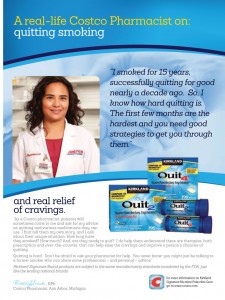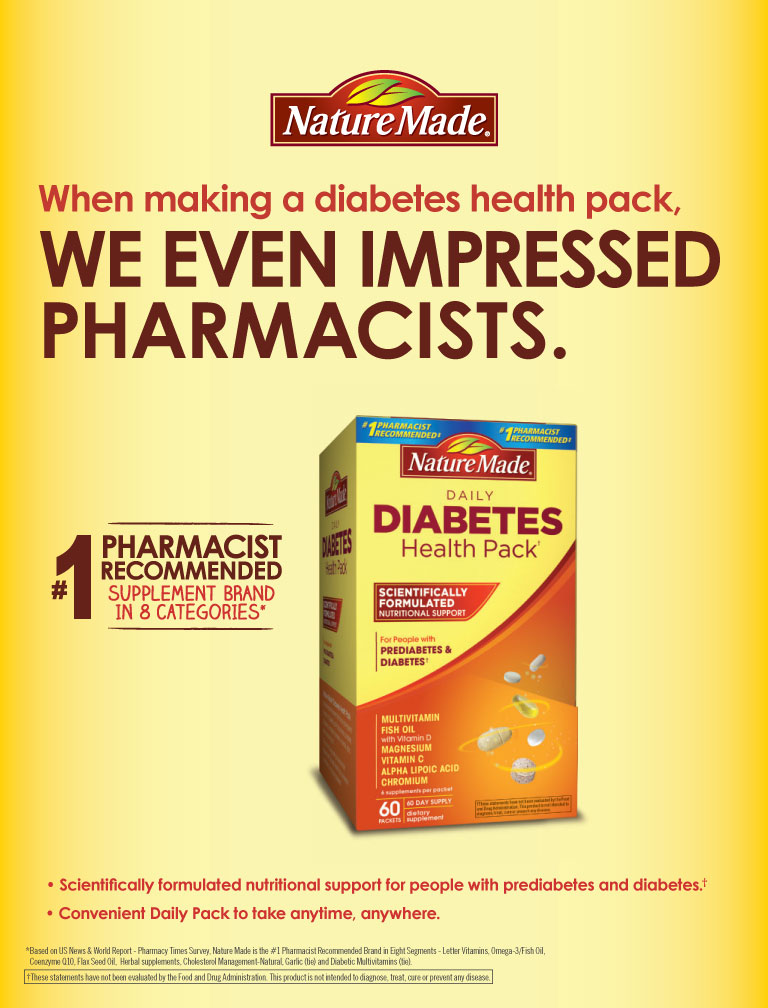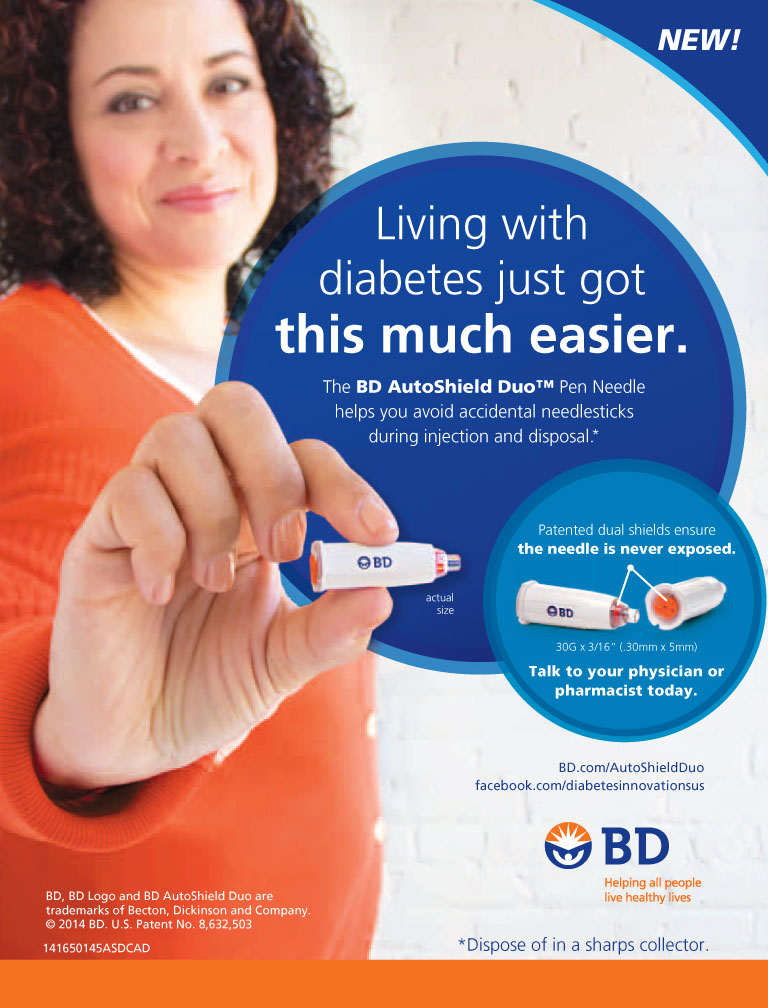
Robbie Almeida, a Costco pharmacist in Ann Arbor, Michigan, finally?quit smoking?after 15 years of advising her customers to do the same. This is how she did it. As a pharmacist, Robbie knew about the health benefits of vitamins and other supplements. She also knew that certain vitamins and supplements would help her?quit smoking. “I take a multivitamin. I take triglycerides. I take flaxseed oil, probiotics and CoQ10. And I take a calcium pill.” Robbie tells her customers at Costco pharmacy that wanting to?quit?is the first big step. For Robbie, once she made that decision, the rest followed easily. “Honestly, I just did it cold turkey. I remember I had my last cigarette at my friend’s house, and I was done. I stayed away from smoking areas so I wasn’t tempted or craving or anything like that. I wanted to?quit, so that’s how I did it. Now if I smell cigarette smoke it makes me ill. I don’t like it at all, and I think, ‘Oh, that was really gross.’ How could I have been doing that for so long?” Most people won’t be able to?quit?cold turkey like Robbie, but making that decision is an important first step. Even when she was smoking, Robbie knew that she was harming her health. Like so many people, she started smoking as a teenager. She thought “everyone” was doing it, and it seemed so cool. Then, as a pharmacist, she had to talk to her customers about the risks of smoking and advise them to?quit. It was hard to hear that smoking raises your risk of heart disease and diabetes almost every day. “The health benefits of it all–how does it make sense to put something foreign into our systems? My kids are nine and eight. They don’t remember when I was still a smoker; it’s been over 10 years. But I tell them about it so that they won’t start like I did. I tell them that it doesn’t make any sense. You’re putting something in your body that doesn’t belong there. “There’s disease. There’s pre-mature death. And the sooner you?quit, the sooner your lungs can start to recover. Back when I was smoking, I had pleurisy in my lungs, like there was an infection in the lining. Right now I feel that my lungs are probably close to 100% healthy.” Robbie?quit?soon after finishing pharmacy school. She admits that she smoked through school because of the stress. But learning about lung cancer, heart disease, strokes–she realized that it was time. She also saw what it was doing to her patients. “We measure patients’ lung capacity, and every year or so and I have to talk to the smokers about the benefits of?stopping.?You can tell right away when they blow into the tube and they can’t breathe that they have had decades of smoking. It’s really bad. And then of course they have to rely on drugs, like inhalers, and everything else that goes along with smoking-related diseases, and all that is very costly. So, it doesn’t make any sense. “I’ve had patients come to me with nicotine gum and ask me whether it works or not. I tell them that they have to be willing to quit, because if they’re not, nothing will really work. I haven’t been monitoring exactly how many patches or over-the-counter products people are buying now thanks to their New Year’s resolutions, but more people are coming to the pharmacy and talking to me about?quitting. “I believe in determination. In my mind I was done smoking, so that’s why I was able toquit. It’s up to each individual to realize the benefits of?quitting?and to decide how to do it. A lot of people use the gum or the patch. That’s fine. With the gum, heavy smokers can start off with a higher dosage to decrease the craving, and then gradually decrease the dose as they start smoking less. They taper down until they get to the lower dose and then, hopefully, the cravings won’t be there and they will have?quit.” Family history also plays a role. Robbie’s father smoked until she was born. Like Robbie, he?stopped?before his children saw him smoking. But Robbie’s grandfather smoked and great grandmother also smoked. Robbie’s grandfather died of complications from smoking; most likely, it aggravated his heart disease. Robbie has been taking calcium ever since she finished school to avoid osteoporosis. She wants to keep strong bones so that she’ll be healthy for his children “A lot of older smokers don’t think like that. They are pretty much addicted and they can’t stop. My children are always on my mind. I have to be healthy for them, so everything that I’m doing is so that I can be with them longer.” By?Jonathan Jarashow
The post Quitting Smoking: A Costco pharmacist’s story appeared first on Fall 2015 Issue | CDiabetes Online Magazine.
]]>
 Robbie Almeida, a Costco pharmacist in Ann Arbor, Michigan, finally?quit smoking?after 15 years of advising her customers to do the same. This is how she did it.
Robbie Almeida, a Costco pharmacist in Ann Arbor, Michigan, finally?quit smoking?after 15 years of advising her customers to do the same. This is how she did it.
As a pharmacist, Robbie knew about the health benefits of vitamins and other supplements. She also knew that certain vitamins and supplements would help her?quit smoking.
“I take a multivitamin. I take triglycerides. I take flaxseed oil, probiotics and CoQ10. And I take a calcium pill.”
Robbie tells her customers at Costco pharmacy that wanting to?quit?is the first big step. For Robbie, once she made that decision, the rest followed easily.
“Honestly, I just did it cold turkey. I remember I had my last cigarette at my friend’s house, and I was done. I stayed away from smoking areas so I wasn’t tempted or craving or anything like that. I wanted to?quit, so that’s how I did it. Now if I smell cigarette smoke it makes me ill. I don’t like it at all, and I think, ‘Oh, that was really gross.’ How could I have been doing that for so long?”
Most people won’t be able to?quit?cold turkey like Robbie, but making that decision is an important first step.
Even when she was smoking, Robbie knew that she was harming her health. Like so many people, she started smoking as a teenager. She thought “everyone” was doing it, and it seemed so cool. Then, as a pharmacist, she had to talk to her customers about the risks of smoking and advise them to?quit. It was hard to hear that smoking raises your risk of heart disease and diabetes almost every day.
“The health benefits of it all–how does it make sense to put something foreign into our systems? My kids are nine and eight. They don’t remember when I was still a smoker; it’s been over 10 years. But I tell them about it so that they won’t start like I did. I tell them that it doesn’t make any sense. You’re putting something in your body that doesn’t belong there.
“There’s disease. There’s pre-mature death. And the sooner you?quit, the sooner your lungs can start to recover. Back when I was smoking, I had pleurisy in my lungs, like there was an infection in the lining. Right now I feel that my lungs are probably close to 100% healthy.”
Robbie?quit?soon after finishing pharmacy school. She admits that she smoked through school because of the stress. But learning about lung cancer, heart disease, strokes–she realized that it was time. She also saw what it was doing to her patients.
“We measure patients’ lung capacity, and every year or so and I have to talk to the smokers about the benefits of?stopping.?You can tell right away when they blow into the tube and they can’t breathe that they have had decades of smoking. It’s really bad. And then of course they have to rely on drugs, like inhalers, and everything else that goes along with smoking-related diseases, and all that is very costly. So, it doesn’t make any sense.
“I’ve had patients come to me with nicotine gum and ask me whether it works or not. I tell them that they have to be willing to quit, because if they’re not, nothing will really work. I haven’t been monitoring exactly how many patches or over-the-counter products people are buying now thanks to their New Year’s resolutions, but more people are coming to the pharmacy and talking to me about?quitting.
“I believe in determination. In my mind I was done smoking, so that’s why I was able toquit. It’s up to each individual to realize the benefits of?quitting?and to decide how to do it. A lot of people use the gum or the patch. That’s fine. With the gum, heavy smokers can start off with a higher dosage to decrease the craving, and then gradually decrease the dose as they start smoking less. They taper down until they get to the lower dose and then, hopefully, the cravings won’t be there and they will have?quit.”
Family history also plays a role. Robbie’s father smoked until she was born. Like Robbie, he?stopped?before his children saw him smoking. But Robbie’s grandfather smoked and great grandmother also smoked. Robbie’s grandfather died of complications from smoking; most likely, it aggravated his heart disease. Robbie has been taking calcium ever since she finished school to avoid osteoporosis. She wants to keep strong bones so that she’ll be healthy for his children
“A lot of older smokers don’t think like that. They are pretty much addicted and they can’t stop. My children are always on my mind. I have to be healthy for them, so everything that I’m doing is so that I can be with them longer.”
By?Jonathan Jarashow
The post Quitting Smoking: A Costco pharmacist’s story appeared first on Fall 2015 Issue | CDiabetes Online Magazine.
]]>
When injecting insulin, there are many things you have to manage to make sure your blood sugars, are controlled.?Aside from your actual insulin plan, you must monitor your blood sugars to make sure that they aren’t too low and?that your plan is helping you reach your blood sugar goal. Often times not much thought goes into the importance of?how and where the insulin is taken. It is recommended that insulin be injected into the fatty layer where it is consistently absorbed. The time it takes for?insulin to be absorbed and begin working in your body is important to make sure that the blood sugar is controlled.?The absorption won’t be what is expected when it is injected into the muscle and unhealthy injection sites. Unhealthy?injection sites include those with bruising, scars, and lipohypertophy. Lipohypertrophy, or lipo for short, is when the fatty layer at the injection site grows too much leaving lumps that can?be seen or in many cases just felt under the skin.1 If lipo forms, you must avoid injecting into it. Less insulin may be?absorbed when injected into lipo which can cause high blood sugars.2 Also when you move from injecting into the lipo?to healthy sites, more insulin is absorbed through the healthy site compared to sites with lipo which could lead to low?blood sugars. This constant movement between high blood sugars to low blood sugars can make it difficult to reach?your average blood glucose goal (A1c). Improper site rotation and using needles more than once have been shown to increase the risk of forming lipo. Using?the same needle multiple times increases the risk of forming lipo.3 They should only be used once with each injection.?Practicing proper site rotation and avoiding the reuse of needles are ways you can prevent lipo and the problems they?cause with blood sugar control. What you can do to prevent lipo: Select one of the injection sites below: Stomach Thigh Arm Buttocks Rotate within your injection site It is suggested to inject within a site for a few days before moving to a new site Each injection should be at least a finger width apart Use a new needle with each injection This article is brought to you by BD. Richardson T, Kerr D. Skin related complications of insulin therapy: Epidemiology and emerging management strategies. Am J Clin Dermatol 2003;4:661-7. Johansson UB, Amberg S, Hannerz L, et al. Impaired absorption of insulin aspart from lipohypertrophic injection sites. Diabetes Care. 2005;28:2025-2027. Blanco M, Hernandez MT, et al. Prevalence and risk factors of lipohypertrophy in insulin-injecting patients with diabetes. Diabetes Metab. 2013;39(5):445-53. by Ader Jean, Pharm. D.
The post What Patients Who Inject Insulin Need To Know appeared first on Fall 2015 Issue | CDiabetes Online Magazine.
]]>
When injecting insulin, there are many things you have to manage to make sure your blood sugars, are controlled.?Aside from your actual insulin plan, you must monitor your blood sugars to make sure that they aren’t too low and?that your plan is helping you reach your blood sugar goal. Often times not much thought goes into the importance of?how and where the insulin is taken.
It is recommended that insulin be injected into the fatty layer where it is consistently absorbed. The time it takes for?insulin to be absorbed and begin working in your body is important to make sure that the blood sugar is controlled.?The absorption won’t be what is expected when it is injected into the muscle and unhealthy injection sites. Unhealthy?injection sites include those with bruising, scars, and lipohypertophy.
Lipohypertrophy, or lipo for short, is when the fatty layer at the injection site grows too much leaving lumps that can?be seen or in many cases just felt under the skin.1 If lipo forms, you must avoid injecting into it. Less insulin may be?absorbed when injected into lipo which can cause high blood sugars.2 Also when you move from injecting into the lipo?to healthy sites, more insulin is absorbed through the healthy site compared to sites with lipo which could lead to low?blood sugars. This constant movement between high blood sugars to low blood sugars can make it difficult to reach?your average blood glucose goal (A1c).
Improper site rotation and using needles more than once have been shown to increase the risk of forming lipo. Using?the same needle multiple times increases the risk of forming lipo.3 They should only be used once with each injection.?Practicing proper site rotation and avoiding the reuse of needles are ways you can prevent lipo and the problems they?cause with blood sugar control.
What you can do to prevent lipo:
- Select one of the injection sites below:
- Stomach
- Thigh
- Arm
- Buttocks
- Rotate within your injection site
- It is suggested to inject within a site for a few days before moving to a new site
- Each injection should be at least a finger width apart
- Use a new needle with each injection
This article is brought to you by BD.
- Richardson T, Kerr D. Skin related complications of insulin therapy: Epidemiology and emerging management strategies. Am J Clin Dermatol 2003;4:661-7.
- Johansson UB, Amberg S, Hannerz L, et al. Impaired absorption of insulin aspart from lipohypertrophic injection sites. Diabetes Care. 2005;28:2025-2027.
- Blanco M, Hernandez MT, et al. Prevalence and risk factors of lipohypertrophy in insulin-injecting patients with diabetes. Diabetes Metab. 2013;39(5):445-53.
by Ader Jean, Pharm. D.
The post What Patients Who Inject Insulin Need To Know appeared first on Fall 2015 Issue | CDiabetes Online Magazine.
]]>
WHAT YOU SHOULD KNOW ABOUT THE LINK BETWEEN THIS SIMPLE MEDICATION AND THESE SERIOUS CONDITIONS
The post Aspirin, Diabetes & Heart Disease appeared first on Fall 2015 Issue | CDiabetes Online Magazine.
]]>
WHAT YOU SHOULD KNOW ABOUT THE LINK BETWEEN THIS SIMPLE MEDICATION AND THESE SERIOUS CONDITIONS.
Do you, or does someone?you know, take an aspirin?every day to lower the?risk of a heart attack??Heart disease is the No. 1?killer of Americans, and?millions of Americans take?an aspirin every day.
If you have diabetes, your?risk of heart disease is two?to four times greater than?people without diabetes.?Taking an aspirin could?be even more important?for you than for others.
However, there are some?risks in taking aspirin,?and not everyone should?take it. The American?Diabetes Association has?provided a set of guidelines?to help people know if?they should take aspirin.
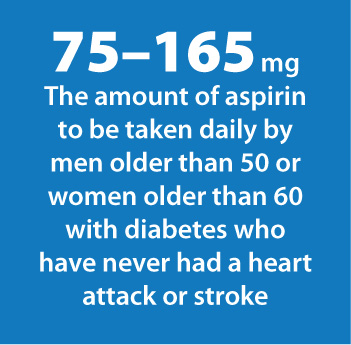 How does aspirin?lower your risk?of heart disease?
How does aspirin?lower your risk?of heart disease?
Heart disease starts when?vessels that bring blood to?the heart are damaged by?unhealthy conditions, such?as high blood pressure, high?cholesterol and smoking.?As the damage continues,thick, fatty deposits made?up of cholesterol and?calcium build up inside?the blood vessels, called?plaque. This narrows the?blood vessels and limits?the amount of blood that?can pass through them.
Sometimes one of these?plaques breaks open. When?this happens, a blood clot?can form in the blood?vessel and stop blood?from getting back to the?heart muscle. Without?blood, the heart starts to?die—this is a heart attack.
Aspirin can help stop the?blood clot from forming.?The first thing that happens?when a blood clot forms?is that cells in your blood,?called platelets, stick to the?injured area. This happens?if the injury is a cut on?your finger or if it occurs?inside your blood vessels.
Aspirin works by making?platelets less sticky so they?don’t form a blood clot in?a potentially dangerous?place—such as inside?your blood vessels.
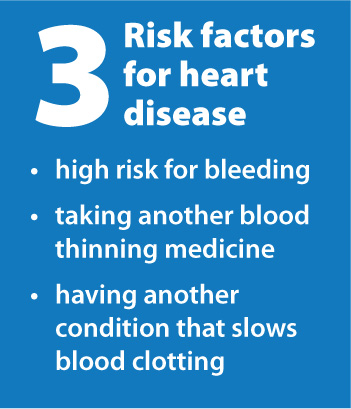 Can taking aspirin?cause problems?
Can taking aspirin?cause problems?
Aspirin can cause some?problems, but the risks are?very small. Because aspirin?makes it harder for your?blood to clot, bleeding may?occur in your blood vessels?as well as other parts of?the body. This is because?aspirin makes it harder ?for?your blood to clot, not just?in blood vessels but also in?other parts of your body.
With any medicine,?there is a balance between?the benefit and the risk?of taking it. With aspirin,?the risk of bleeding is very?low. You won’t bleed to?death if you cut your finger?while making dinner, but if?you’re in a bad car accident,
it may be harder to stop?the bleeding from any?injuries that may occur.
Fortunately, serious?accidents don’t happen?too often, but this is still?a good reason why you?shouldn’t take an aspirin?without first talking with?your healthcare provider.
What do the guidelines?say about who should?take aspirin?
Your healthcare provider?will help you understand?your heart disease risk,?and can decide if you?are a low, medium, or?high risk based on:
- your age
- your gender (men are at?greater risk than women)
- family history of?heart disease
- if you smoke
- other medical problems,?like high cholesterol,?high blood pressure,?diabetes and obesity.
by Robert Ehrman MD
The post Aspirin, Diabetes & Heart Disease appeared first on Fall 2015 Issue | CDiabetes Online Magazine.
]]>
SOME PRACTICAL TIPS TO HELP YOU FEEL SAFE AND RELAXED ON YOUR TRIP Having diabetes doesn’t mean you can’t travel. But before you pack your bags, it’s important to make sure you have a plan in place to manage your diabetes while you’re away from home. Here are five tips that will make it easier to take care of yourself when you travel. 1?Talk with your?healthcare provider Speak to your?healthcare?provider at least?one month before?you leave to let?him or her know?how long you?plan to be away,?and if you’ll be in?a different time?zone. He or she?may need to adjust?your insulin dose,?medicines, or meal?plan. Make sure all?of your medicines?are up-to-date?before you leave?for your trip. ?Your healthcare?provider can?also provide you?with a letter that?says you have?diabetes. Keep?it handy when?you go through?security at the?airport. It should?explain why you?need to bring your?diabetes supplies?with you, and?why they can’t?be put into your?checked baggage. 2?Watch your?portions Have you noticed that many restaurants?serve huge portions? You don’t have?to pack on the pounds when you?travel. Steer clear of all-you-can-eat?buffets. Food choices at buffets may?be high in salt, unhealthy fats, sugars?and calories, and low in fiber. Plus,?it’s easy to eat too much food if it?is offered in unlimited portions.?Pick a restaurant that serves smaller?portions of tasty food. At dinner,?order an appetizer or lunch portion?as your main course. Enjoy a fresh?salad and grilled or roasted vegetables?on the side. Look for healthy words?on menus, such as broiled, roasted or?grilled. Enjoy a tall glass of water or?unsweetened tea with your meal. 3?Test your?blood glucose Do the best you can to get your blood?glucose levels to your target range before?you travel. Test more often before your?trip so that you know what changes?you’ll have to make to reach this goal.?Try to test the same amount when you?are away from home. You will enjoy?your trip more if you aren’t worried?about your blood glucose levels. 4?Bring extra?supplies What if you stay away longer?than you had planned? What?if your flight is late or you’re?caught in a traffic jam? Here’s?the answer: bring at least double?the amount of daily pills,?insulin and diabetes supplies?that you think you’ll need.?Don’t skimp on extra supplies.?Keep your supplies close when?you travel. Make sure snacks and?testing supplies are within reach?at all times. You should always?be able to get your meter or?glucose tablets in case your blood?glucose drops. Clearly mark all?diabetes supplies and keep the pharmacy’s original labeling?on them wherever possible. 5?Keep?moving Try to keep up with your exercise?routine when you’re away?from home. Plan to walk every?hour when you travel by air,?bus, train or car. Take a walk to?help prevent blood clots. Need?another reason? Physical activity?can help keep your blood glucose?level within your target range.?Call your hotel before your trip?to find out if there is a gym or?walking path nearby. Wouldn’t?it be fun to take a walk with?your travel partner? You can?exercise and sightsee at the same?time. Plan to stay active each?day, even when you travel. ? By Susan Weiner, MS, RDN, CDE, CDN
The post Tips For Traveling With Diabetes appeared first on Fall 2015 Issue | CDiabetes Online Magazine.
]]>
The post Tips For Traveling With Diabetes appeared first on Fall 2015 Issue | CDiabetes Online Magazine.
]]>
If you have diabetes, you probably know that you are at an increased risk for problems with your eyes, feet, skin?and nervous system. Did you know that diabetes can also cause problems in your mouth? Take Care Of Your Teeth Poor blood glucose control lets bacteria grow easily in your mouth. Having lots of bacteria in your mouth lead to?plaque buildup on your teeth. When this happens, your gums begin to pull away from your teeth, and pockets form between your teeth and gums. These pockets can become filled with germs and small bits of food. The gums then become inflamed and may bleed when you eat or brush your teeth. This condition is called “gingivitis”. Keeping your gums healthy is important because they help to hold your teeth in place. If nothing is done, you can get an infection in your gums that can go on to destroy the bone around your teeth, and they may start to move. Your teeth may fall out or need to be pulled. A recent study at the University of Copenhagen in Denmark looked at the link between oral health and diabetes. The study found that people with good oral health practices, along with a healthy diet and good stress management, had?lower blood glucose levels and healthier teeth and gums. Diabetes: A Major Cause Of Gum Disease There are many causes of gum disease, including smoking, hormonal changes, and certain cancers. Some medicines can?make your mouth dry, which can increase your risk for tooth and gum problems. This is because saliva helps slow the growth of bacteria and keeps your mouth healthy overall. Poorly controlled diabetes can also lead to gum disease. High levels of sugar in saliva make it easy for bacteria to grow there. This is why poorly controlled diabetes is a risk factor for gum disease. Also, diabetes can cause problems with blood flow to your teeth and gums. This makes it harder to repair damage to your gums and fight infection. It is also important to understand that if you develop gum disease from poor oral habits or other reasons, this could make it harder for you to control your diabetes. Other oral problems related to diabetes include: Thrush: this is an infection caused by a fungus that grows in the mouth and throat Dry mouth: this can cause soreness, ulcers, infections and cavities Dental Check-ups Are Important It’s important that you tell your dentist if you have diabetes, and keep them informed of any changes in your condition or medicines. Postpone any non-emergency dental procedures if your blood sugar is not well controlled. What Can You Do To Keep Your Mouth Healthy? The most important thing you can do is control your blood glucose levels. Have dental check-ups every six months?if possible. Avoid smoking and, if you wear dentures, remove and clean them every day. Good blood glucose control can also help prevent or relieve the dry mouth diabetes can cause. Here are some simple tips for a healthy mouth: Keep your blood glucose level under control Brush and floss every day Visit your dentist at least every 6 months. Be sure to tell them that you have diabetes Tell your dentist if your dentures do not fit right, or if your gums are sore Stop smoking. Your healthcare provider or dentist can tell you about what options there are to help you quit Call your dentist if you notice a problem. Take time to check your mouth regularly for any problems. If your gums bleed when you brush or floss, or if you notice dryness, soreness, white patches, or a bad taste in your mouth, contact your dentist right away. Remember, good blood glucose control can help keep your mouth happy and healthy for years to come. 6 Signs Of Gum Disease Red or swollen gums Gums that bleed easily when brushing or flossing Receding gums (pulling away from teeth) Loose teeth, making it hard to bite and chew Constant bad breath Dentures that don’t fit anymore By Robert Ehrman, MD
The post Oral Health And Diabetes appeared first on Fall 2015 Issue | CDiabetes Online Magazine.
]]>
If you have diabetes, you probably know that you are at an increased risk for problems with your eyes, feet, skin?and nervous system. Did you know that diabetes can also cause problems in your mouth?
Take Care Of Your Teeth
Poor blood glucose control lets bacteria grow easily in your mouth. Having lots of bacteria in your mouth lead to?plaque buildup on your teeth. When this happens, your gums begin to pull away from your teeth, and pockets form between your teeth and gums. These pockets can become filled with germs and small bits of food. The gums then become inflamed and may bleed when you eat or brush your teeth. This condition is called “gingivitis”.
Keeping your gums healthy is important because they help to hold your teeth in place. If nothing is done, you can get an infection in your gums that can go on to destroy the bone around your teeth, and they may start to move. Your teeth may fall out or need to be pulled.
A recent study at the University of Copenhagen in Denmark looked at the link between oral health and diabetes. The study found that people with good oral health practices, along with a healthy diet and good stress management, had?lower blood glucose levels and healthier teeth and gums.
Diabetes: A Major Cause Of Gum Disease
There are many causes of gum disease, including smoking, hormonal changes, and certain cancers. Some medicines can?make your mouth dry, which can increase your risk for tooth and gum problems. This is because saliva helps slow the growth of bacteria and keeps your mouth healthy overall. Poorly controlled diabetes can also lead to gum disease.
High levels of sugar in saliva make it easy for bacteria to grow there. This is why poorly controlled diabetes is a risk factor for gum disease. Also, diabetes can cause problems with blood flow to your teeth and gums. This makes it harder to repair damage to your gums and fight infection. It is also important to understand that if you develop gum disease from poor oral habits or other reasons, this could make it harder for you to control your diabetes.
Other oral problems related to diabetes include:
- Thrush: this is an infection caused by a fungus that grows in the mouth and throat
- Dry mouth: this can cause soreness, ulcers, infections and cavities
Dental Check-ups Are Important
It’s important that you tell your dentist if you have diabetes, and keep them informed of any changes in your condition or medicines. Postpone any non-emergency dental procedures if your blood sugar is not well controlled.
What Can You Do To Keep Your Mouth Healthy?
The most important thing you can do is control your blood glucose levels. Have dental check-ups every six months?if possible. Avoid smoking and, if you wear dentures, remove and clean them every day. Good blood glucose control can also help prevent or relieve the dry mouth diabetes can cause.
Here are some simple tips for a healthy mouth:
- Keep your blood glucose level under control
- Brush and floss every day
- Visit your dentist at least every 6 months. Be sure to tell them that you have diabetes
- Tell your dentist if your dentures do not fit right, or if your gums are sore
- Stop smoking. Your healthcare provider or dentist can tell you about what options there are to help you quit
- Call your dentist if you notice a problem.
Take time to check your mouth regularly for any problems. If your gums bleed when you brush or floss, or if you notice dryness, soreness, white patches, or a bad taste in your mouth, contact your dentist right away. Remember, good blood glucose control can help keep your mouth happy and healthy for years to come.
6 Signs Of Gum Disease
- Red or swollen gums
- Gums that bleed easily when brushing or flossing
- Receding gums (pulling away from teeth)
- Loose teeth, making it hard to bite and chew
- Constant bad breath
- Dentures that don’t fit anymore
By Robert Ehrman, MD
The post Oral Health And Diabetes appeared first on Fall 2015 Issue | CDiabetes Online Magazine.
]]>
First, it is important to note that eating a variety of whole foods is a better choice for staying healthy than relying on vitamins or supplements.?Eating lean meats, vegetables, fruits, and whole grains- and limiting fats and sugar — are important for keeping your blood glucose under control. Individual foods can give you many different vitamins, minerals, and nutrients, in one?serving. For example, raspberries contain vitamin C, fiber, and antioxidants. These nutrients, plus all?the food nutrients we have not yet discovered, work?together in your body to ensure that you benefit from all of them. Using vitamins or supplements – which do not have the full range of nutrients that whole foods do — may not?be needed unless you have a specific vitamin deficiency. (“Deficiency” means that your body does not have enough?of an important nutrient.) It’s a good idea to talk to your healthcare provider before taking any vitamin supplements to see if you really need them. Your healthcare provider may want you to take?vitamin supplements if you are: On a low-calorie diet and do?not eat a wide variety of foods On a vegan diet (no meat, fish, eggs or dairy products) Pregnant On a restricted diet because you?have food allergies, kidney disease?or have trouble absorbing nutrients What Vitamins Are The Best? Many people, including those with diabetes, may?need to take vitamin D supplements.?Experts say to take 400 international units (IU) each day. Recent studies suggest that this may not be enough vitamin D. Ask your healthcare provider if you ?should take vitamin D supplements,?and how much to take every day. Why Is Vitamin D So Important For Good Health? Vitamin D might be able to: improve pain and tingling in your legs, feet, hands, and fingers. keep bones healthy and strong help with blood glucose control help ease depression in women with type 2 diabetes. How Can I Get More Vitamin D? Go outside in the sunshine. Sunshine is a great way to get vitamin D. To be safe, first check with your healthcare provider to make sure it’s safe for you to spend time in the sun. Eat more fish and egg yolks. Eat cereals with vitamin D added. Drink milk with vitamin D added. Take Vitamin D supplements if your healthcare provider recommends it. Vitamin D and calcium work together. Ask your healthcare provider if it’s a good idea for you to take Vitamin D with a calcium supplement. What about Chromium, and Vitamins C and E? There are some studies showing that these nutrients might be helpful for blood glucose control or heart health, but more research is needed. News stories over the past few years have reported that chromium might decrease body fat and build muscle without you having to change your eating habits. But, studies have not shown that chromium helps you lose weight. Also, it is not known how much chromium you should take. Fortunately, it is relatively safe. In fact, many healthcare providers tell their patients with diabetes to take chromium supplements. However, don’t take a chromium supplement without first talking with your healthcare team and knowing the correct amount to take. You might damage your kidneys if you take too much chromium. Good food sources of chromium include whole grains, bran cereals, seafood, green beans, nuts, peanut butter, and potatoes. People with diabetes may have lower levels of vitamin C in their bodies. This may be because higher blood glucose levels keep vitamin C out of the body’s cells. In one study, people with type 2 diabetes who took 2,000 mg of Vitamin C every day showed improvement in blood glucose and fat levels. However, more studies need to be done to confirm the benefits for people with diabetes so ask your healthcare provider first before taking vitamin C supplements. Some studies say that vitamin E might help prevent health problems such as heart disease, eye problems and kidney damage. However, it’s too early to know if this is true. In addition, experts are not sure how much vitamin E you should take. Vitamin E amounts greater than 800 IU each chance of stroke in people with high blood pressure. Too much vitamin E can also keep medicines that prevent blood clots from working. If you want to take vitamin E, ask your healthcare provider first about the pros and cons and if you do decide to take vitamin E, do not take more than 200 Tips for Taking Supplements Pick supplements with no more than 100 to 150 percent of the daily value for the listed vitamins and minerals Women who have gone through menopause should choose a supplement without iron Choose a brand that has the USP seal on the package. A USP (U.S. Pharmacopeia) seal says the product has been tested for strength and purity Check expiration dates; do not use expired supplements Keep supplements in a cool, dry place, and out of reach of children. By Robert Ehrman, MD ? Reviewed by Fran Daniel, MPH
The post Vitamins and Diabetes Care appeared first on Fall 2015 Issue | CDiabetes Online Magazine.
]]>
First, it is important to note that eating a variety of whole foods is a better choice for staying healthy than relying on vitamins or supplements.?Eating lean meats, vegetables, fruits, and whole grains- and limiting fats and sugar — are important for keeping your blood glucose under control.
Individual foods can give you many different vitamins, minerals, and nutrients, in one?serving. For example, raspberries contain vitamin C, fiber, and antioxidants. These nutrients, plus all?the food nutrients we have not yet discovered, work?together in your body to ensure that you benefit from all of them. Using vitamins or supplements – which do not have the full range of nutrients that whole foods do — may not?be needed unless you have a specific vitamin deficiency. (“Deficiency” means that your body does not have enough?of an important nutrient.) It’s a good idea to talk to your healthcare provider before taking any vitamin supplements to see if you really need them.
Your healthcare provider may want you to take?vitamin supplements if you are:
- On a low-calorie diet and do?not eat a wide variety of foods
- On a vegan diet (no meat, fish, eggs or dairy products)
- Pregnant
- On a restricted diet because you?have food allergies, kidney disease?or have trouble absorbing nutrients
What Vitamins Are The Best?
Many people, including those with diabetes, may?need to take vitamin D supplements.?Experts say to take 400 international units (IU) each day. Recent studies suggest that this may not be enough vitamin D. Ask your healthcare provider if you ?should take vitamin D supplements,?and how much to take every day.
Why Is Vitamin D So Important For Good Health?
Vitamin D might be able to:
- improve pain and tingling in your legs, feet, hands, and fingers.
- keep bones healthy and strong
- help with blood glucose control
- help ease depression in women with type 2 diabetes.
How Can I Get More Vitamin D?
-
Go outside in the sunshine. Sunshine is a great way to get vitamin D. To be safe, first check with your healthcare provider to make sure it’s safe for you to spend time in the sun.
- Eat more fish and egg yolks.
- Eat cereals with vitamin D added.
- Drink milk with vitamin D added.
- Take Vitamin D supplements if your healthcare provider recommends it.
- Vitamin D and calcium work together. Ask your healthcare provider if it’s a good idea for you to take Vitamin D with a calcium supplement.
What about Chromium, and Vitamins C and E?
There are some studies showing that these nutrients might be helpful for blood glucose control or heart health, but more research is needed. News stories over the past few years have reported that chromium might decrease body fat and build muscle without you having to change your eating habits. But, studies have not shown that chromium helps you lose weight. Also, it is not known how much chromium you should take. Fortunately, it is relatively safe. In fact, many healthcare providers tell their patients with diabetes to take chromium supplements. However, don’t take a chromium supplement without first talking with your healthcare team and knowing the correct amount to take. You might damage your kidneys if you take too much chromium. Good food sources of chromium include whole grains, bran cereals, seafood, green beans, nuts, peanut butter, and potatoes.
People with diabetes may have lower levels of vitamin C in their bodies. This may be because higher blood glucose levels keep vitamin C out of the body’s cells. In one study, people with type 2 diabetes who took 2,000 mg of Vitamin C every day showed improvement in blood glucose and fat levels. However, more studies need to be done to confirm the benefits for people with diabetes so ask your healthcare provider first before taking vitamin C supplements. Some studies say that vitamin E might help prevent health problems such as heart disease, eye problems and kidney damage. However, it’s too early to know if this is true. In addition, experts are not sure how much vitamin E you should take. Vitamin E amounts greater than 800 IU each chance of stroke in people with high blood pressure. Too much vitamin E can also keep medicines that prevent blood clots from working. If you want to take vitamin E, ask your healthcare provider first about the pros and cons and if you do decide to take vitamin E, do not take more than 200
Tips for Taking
Supplements
- Pick supplements with no more than 100 to 150 percent of the daily value for the listed vitamins and minerals
- Women who have gone through menopause should choose a supplement without iron
- Choose a brand that has the USP seal on the package. A USP (U.S. Pharmacopeia) seal says the product has been tested for strength and purity
- Check expiration dates; do not use expired supplements
- Keep supplements in a cool, dry place, and out of reach of children.
By Robert Ehrman, MD ? Reviewed by Fran Daniel, MPH
The post Vitamins and Diabetes Care appeared first on Fall 2015 Issue | CDiabetes Online Magazine.
]]>
Many people with diabetes do not want to start insulin or other injected diabetes medications because they have many fears. Some people fear needles, injection pain or worry about taking a shot. Some people have concerns about the safety or convenience of diabetes injections. Some people even fear that starting injected medications is the “end of the road”. Your community pharmacist can answer your questions about injected diabetes medications and can help you make the right choices to help you achieve your blood glucose goals. We have made great strides in treating diabetes over the last decade. One of the big changes is that insulin and other injectable medications are being prescribed more often and much earlier to improve health. They work very well to manage blood glucose, but they do require an injection. Luckily, most of these medications are now available in pen devices and some manufacturers are continuing to introduce newer, innovative pen needles. The BD AutoShield Duo? Pen Needle is a pen needle for patients who inject diabetes medications at home that may?appeal to people who have fears or concerns about injecting themselves. This pen needle has been used by healthcare?professionals in hospitals for years. The BD AutoShield Duo? Pen Needle has shields on both the front and back of the needle which help avoid accidental needle sticks before and after injecting. The shields also may help make the injection process easier for patients that are anxious about injections because the needle is concealed during the entire process. The BD AutoShield Duo? Pen Needle is also shorter and thinner than many older needles. Some people have been told that they should use longer needles because they are heavy or have thicker skin. But, the latest research shows that new, shorter needles are just as effective as longer needles used in the past and can be used in almost everyone, regardless of sex, weight, or skin thickness1. This is important because longer needles tend to be more painful. And, more importantly, longer needles can accidentally enter into muscle which can lead to lots of changes?in blood sugar levels and may increase pain. Shorter needles are safer and less painful because they enter into the fat tissue right under the skin. The BD AutoShield Duo? Pen Needle also offers some conveniences. It is easier to handle than standard pen needles?which may benefit people with arthritis or reduced dexterity. The short needle length means that you can inject without pinching up your skin,*2 there’s no inner needle shield to remove and the needle does not need to be re-capped to be removed from the pen. This means two less steps in the injection process! If your doctor recommends insulin or another injectable medication for you, ask your pharmacist about the BD AutoShield Duo? Pen Needle. It fits on all leading diabetes pen devices in the U.S. and is covered by most insurance plans. #¥Your pharmacist can help you decide whether it is the right pen needle for you. # Compatible with all leading insulin and GLP-1 pens in the US as of May 2014, ISO-compliant. ¥ Co-pays and preferred status vary by plan. * Patients ages 2-6, those who are extremely lean or with loose skin may require a pinch-up. If using pinch-up: Do not place fingers less than 1 inch (2.5cm) apart. Do not insert the penneedle at an angle towards your fingers. 1. Hirsch et al. Comparative glycemic control, safety and patient ratings. 2.Frid, et al. Diabetes and Metabolism, 2010 Jennifer Trujillo, PharmD, BCPS, CDE | Associate Professor This article is brought to you by?
The post A Diabetes Pen Needle That Helps Avoid Accidental Needle Sticks appeared first on Fall 2015 Issue | CDiabetes Online Magazine.
]]>
Many people with diabetes do not want to start insulin or other injected diabetes medications because they have many fears. Some people fear needles, injection pain or worry about taking a shot. Some people have concerns about the safety or convenience of diabetes injections. Some people even fear that starting injected medications is the “end of the road”. Your community pharmacist can answer your questions about injected diabetes medications and can help you make the right choices to help you achieve your blood glucose goals.
We have made great strides in treating diabetes over the last decade. One of the big changes is that insulin and other injectable medications are being prescribed more often and much earlier to improve health. They work very well to manage blood glucose, but they do require an injection. Luckily, most of these medications are now available in pen devices and some manufacturers are continuing to introduce newer, innovative pen needles.
 The BD AutoShield Duo
The BD AutoShield Duo Pen Needle is a pen needle for patients who inject diabetes medications at home that may?appeal to people who have fears or concerns about injecting themselves. This pen needle has been used by healthcare?professionals in hospitals for years. The BD AutoShield Duo
Pen Needle is a pen needle for patients who inject diabetes medications at home that may?appeal to people who have fears or concerns about injecting themselves. This pen needle has been used by healthcare?professionals in hospitals for years. The BD AutoShield Duo Pen Needle has shields on both the front and back of the needle which help avoid accidental needle sticks before and after injecting. The shields also may help make the injection process easier for patients that are anxious about injections because the needle is concealed during the entire process.
Pen Needle has shields on both the front and back of the needle which help avoid accidental needle sticks before and after injecting. The shields also may help make the injection process easier for patients that are anxious about injections because the needle is concealed during the entire process.
The BD AutoShield Duo Pen Needle is also shorter and thinner than many older needles. Some people have been told that they should use longer needles because they are heavy or have thicker skin. But, the latest research shows that new, shorter needles are just as effective as longer needles used in the past and can be used in almost everyone, regardless of sex, weight, or skin thickness1. This is important because longer needles tend to be more painful. And, more importantly, longer needles can accidentally enter into muscle which can lead to lots of changes?in blood sugar levels and may increase pain. Shorter needles are safer and less painful because they enter into the fat tissue right under the skin.
Pen Needle is also shorter and thinner than many older needles. Some people have been told that they should use longer needles because they are heavy or have thicker skin. But, the latest research shows that new, shorter needles are just as effective as longer needles used in the past and can be used in almost everyone, regardless of sex, weight, or skin thickness1. This is important because longer needles tend to be more painful. And, more importantly, longer needles can accidentally enter into muscle which can lead to lots of changes?in blood sugar levels and may increase pain. Shorter needles are safer and less painful because they enter into the fat tissue right under the skin.
The BD AutoShield Duo Pen Needle also offers some conveniences. It is easier to handle than standard pen needles?which may benefit people with arthritis or reduced dexterity. The short needle length means that you can inject without pinching up your skin,*2 there’s no inner needle shield to remove and the needle does not need to be re-capped to be removed from the pen. This means two less steps in the injection process!
Pen Needle also offers some conveniences. It is easier to handle than standard pen needles?which may benefit people with arthritis or reduced dexterity. The short needle length means that you can inject without pinching up your skin,*2 there’s no inner needle shield to remove and the needle does not need to be re-capped to be removed from the pen. This means two less steps in the injection process!
If your doctor recommends insulin or another injectable medication for you, ask your pharmacist about the BD AutoShield Duo Pen Needle. It fits on all leading diabetes pen devices in the U.S. and is covered by most insurance plans. #¥Your pharmacist can help you decide whether it is the right pen needle for you.
Pen Needle. It fits on all leading diabetes pen devices in the U.S. and is covered by most insurance plans. #¥Your pharmacist can help you decide whether it is the right pen needle for you.
# Compatible with all leading insulin and GLP-1 pens in the US as of May 2014, ISO-compliant.
¥ Co-pays and preferred status vary by plan.
* Patients ages 2-6, those who are extremely lean or with loose skin may require a pinch-up.
If using pinch-up: Do not place fingers less than 1 inch (2.5cm) apart. Do not insert the penneedle at
an angle towards your fingers.
1. Hirsch et al. Comparative glycemic control, safety and patient ratings.
2.Frid, et al. Diabetes and Metabolism, 2010
Jennifer Trujillo, PharmD, BCPS, CDE | Associate Professor
This article is brought to you by?![]()
The post A Diabetes Pen Needle That Helps Avoid Accidental Needle Sticks appeared first on Fall 2015 Issue | CDiabetes Online Magazine.
]]>
DIABETES PUTS YOU AT RISK FOR ALZHEIMER’S DISEASE AND OTHER BRAIN CONDITIONS
The post Blood Glucose And Your Brain appeared first on Fall 2015 Issue | CDiabetes Online Magazine.
]]>
The post Blood Glucose And Your Brain appeared first on Fall 2015 Issue | CDiabetes Online Magazine.
]]>
When it comes to diabetes management, insulin injections provide many benefits. However, there are obstacles for many people with diabetes.
The post Overcoming Obstacles to Insulin Injections appeared first on Fall 2015 Issue | CDiabetes Online Magazine.
]]>
When it comes to diabetes management, insulin injections provide many benefits. However, there are obstacles for many people with diabetes.
Some are afraid of needles, and others have physical challenges that make it difficult for them to inject; however, if people avoid insulin, when their health care providers recommend it for them, this can lead to diabetes complications, such as amputation, dialysis, blindness and heart disease1. Fortunately, there are new insulin injection tools that can help people with diabetes better manage their condition and live healthier lives.
Fear of Needles
Many people with diabetes associate needles with pain, but due to advancements in technology, today’s needles are smaller, thinner and sharper than ever before. Unifine? Pentips? Plus pen needles offer a wide range of sizes to help people with diabetes find the size that meets their needs best, including one of the smallest sizes available (32G x 4mm). These pen needles are designed to maximize patient comfort, with DiamondPoint Technology and anti-coring treatment shown to decrease penetration force by up to 30 percent2. Unifine Pentips Plus also has Optiflow
Technology and anti-coring treatment shown to decrease penetration force by up to 30 percent2. Unifine Pentips Plus also has Optiflow Technology to help improve drug flow with low delivery force2.
Technology to help improve drug flow with low delivery force2.
Dexterity Challenges and Visual Loss
Two common challenges for people with diabetes are loss of vision and loss of dexterity. These can make it hard to inject insulin. Unifine Pentips Plus pen needles feature an ergonomic shape ideal for those with dexterity issues. The larger container is designed to provide greater grip and control, making it easier to attach and remove pen needles. For those with vision loss, Safety Click Technology? ‘clicks’ to indicate the used pen needle is locked in the chamber. In a comparative study, 86 percent of users indicated changing of pen needles as easy or easier with Unifine Pentips Plus pen needles, with 68 percent of users attributing the device to reduced needlestick injuries3.
Disposal without a Sharps Container
Insulin injections offer more flexibility in when meals are taken4, but not where. When sharps containers are not convenient or available, Unifine Pentips Plus pen needles feature the world’s first built-in remover for the ultimate in On-the-Go? convenience. These pen needles have a built-in locking chamber designed to hold used needles until they can be disposed of safely. Sixty-one percent of patients preferred Unifine Pentips Plus versus their current needle, citing ease of use, convenient disposal and safety as primary benefits. This remarkable device has also been shown to have a significant impact on patient needle changing behavior, revealing a 58 percent increase in patient changing pen needles every time versus their prior needle3.
References
1Grabowski, Fran. “Fear of Needles Creates Obstacles for Patient with Diabetes.” Camden Health. Camden Coalition of Healthcare Providers, 16 Oct. 2012. Web. 2 Oct. 2015.
2Data on file.
3According to users in an 8 week observational behavioral study comparing UnifinePentips Plus to current pen needle. Data on file.
4 “Multiple Dose Insulin Therapy –? Multiple Daily Injections.” DiabetesCoUK. Treatment, n.d. Web. 2 Oct. 2015.
By the www.keixun.com.cn Staff
The post Overcoming Obstacles to Insulin Injections appeared first on Fall 2015 Issue | CDiabetes Online Magazine.
]]>
A NEW PHRASE YOU MAY HEAR AS THE AFFORDABLE CARE ACT GETS UNDERWAY IS PATIENT ENGAGEMENT
The post Patient Engagement appeared first on Fall 2015 Issue | CDiabetes Online Magazine.
]]>
The post Patient Engagement appeared first on Fall 2015 Issue | CDiabetes Online Magazine.
]]>